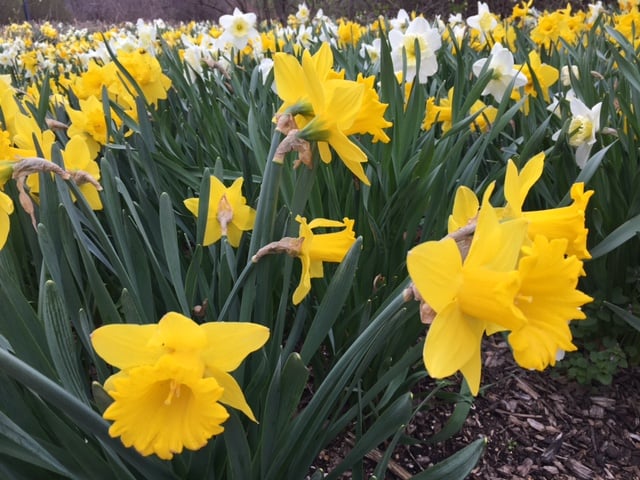
Spring in Chicago has been lush but short. The pink blossoms of the redbud trees are already fading and disappearing among the new green leaves, and sweeps of glorious yellow daffodils blooms have shriveled up, leaving boring green leaves.
Many gardeners are tempted to cut back those leaves as soon as the flowers fade on daffodils and other spring bulb plants. But if you want more flowers next year, don’t do it!
The plants need their leaves right now, to build a new flower for next year in the bulbs underground. It’s an energy-intensive endeavor, and the leaves are a plant’s solar collectors. If you cut off the life-giving leaves, the plant can’t make a bloom for next year: You’ve turned a perennial into an annual.
If they can keep their leaves after they flower, many bulb plants, including daffodils, will live and rebloom for years. I try to wait six or eight weeks until the leaves start to turn yellow. That tells me the plant is done with the leaves and is going dormant for the summer.
Sometimes it’s just not practical to leave the leaves entirely alone. I have Siberian squill (Scilla siberica) growing in my lawn, making a blue carpet in early spring, and I can’t wait to mow the lawn until the squill goes dormant in June. But I wait as long as the neighbors can stand my shaggy lawn. The fact that I always mow my lawn high—3 inches—gives not only my lawn grasses but my squill plants a little more leaf area for collecting sunlight.
If you have pots of bulbs in the greenhouse that you forced for early spring bloom, you have a choice: You can discard them, or you can let them go dormant and then plant them out in the garden. Daffodils and other spring bulbs are not houseplants and can’t stay in the conservatory indefinitely.
When I have a pot of forced bulbs, I usually sprinkle a little slow-release fertilizer on the soil and place it out in the sun. I let the rain water the bulbs for a few weeks until their leaves fade and I know they’re dormant. Then I dig the bulbs out of the pot and plant them into the soil. In fall, I’ll pot up a new container of dormant bulbs for forcing into early bloom in the spring.


